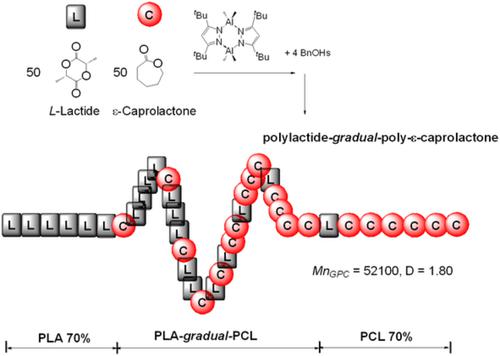当前位置:
X-MOL 学术
›
J. Polym. Sci.
›
论文详情
Our official English website, www.x-mol.net, welcomes your feedback! (Note: you will need to create a separate account there.)
Comparison study of ε‐caprolactone, L‐lactide, and ε‐decalactone polymerizations using aluminum complexes bearing pyrazole derivatives, and synthesis of polylactide‐gradual‐poly‐ε‐caprolactone copolymer
Journal of Polymer Science ( IF 3.4 ) Pub Date : 2020-04-13 , DOI: 10.1002/pol.20190127 Feng‐Jie Lai, Shu‐Chun Yu, Yung‐Chi Chang, Tzu‐Yi Wu, Kuo‐Hui Wu, Yu‐Lun Chang, Shangwu Ding, Hsuan‐Ying Chen, Chian‐Hui Lai
Journal of Polymer Science ( IF 3.4 ) Pub Date : 2020-04-13 , DOI: 10.1002/pol.20190127 Feng‐Jie Lai, Shu‐Chun Yu, Yung‐Chi Chang, Tzu‐Yi Wu, Kuo‐Hui Wu, Yu‐Lun Chang, Shangwu Ding, Hsuan‐Ying Chen, Chian‐Hui Lai

|
This study compared ε‐caprolactone (CL), L‐lactide (LA), and ε‐decalactone (DL) polymerizations, where aluminum complexes bridged by two pyrazole ligands was used as catalysts. The reactivites of these Al complexes between CL, LA, and DL polymerization were different that L
Bu
2Al
2Me
4, with the distort boat form, exhibits the greatest catalytic activity for LA and DL polymerization at 60°C but the lowest catalytic activity for CL polymerization at room temperature. This may be because dinuclear L
Bu
2Al
2Me
4 cannot react with BnOH to form aluminum benzyl oxide at room temperature, making it unable to reduce catalytic activity. Because these aluminum complexes had different reactivities for LA and CL polymerizations, the selectivity of polylactide‐gradual‐poly‐ε‐caprolactones (PLA(10–80%)‐gradual‐PCL(59–79%)) (PLA‐g‐PCLs) was observed.
中文翻译:

使用带有吡唑衍生物的铝配合物进行ε-己内酯,L-丙交酯和ε-癸内酯聚合的比较研究,以及聚丙交酯-逐步-聚ε-己内酯共聚物的合成
这项研究比较了ε-己内酯(CL),L-丙交酯(LA)和ε-十内酯(DL)聚合,其中由两个吡唑配体桥接的铝络合物用作催化剂。这些Al络合物在CL,LA和DL聚合反应中的反应活性不同,L Bu 2 Al 2 Me 4呈扭曲舟状,在60°C时对LA和DL聚合反应具有最大的催化活性,但催化活性最低。在室温下用于CL聚合。这可能是因为双核L Bu 2 Al 2 Me 4 在室温下不能与BnOH反应形成苄基铝,因此不能降低催化活性。因为这些铝络合物对LA和CL聚合反应的反应性不同,所以聚丙交酯-逐步-聚-ε-己内酯(PLA(10-80%)-渐进-PCL(59-79%))(PLA- g- PCLs的选择性) 被观测到。
更新日期:2020-04-13
中文翻译:

使用带有吡唑衍生物的铝配合物进行ε-己内酯,L-丙交酯和ε-癸内酯聚合的比较研究,以及聚丙交酯-逐步-聚ε-己内酯共聚物的合成
这项研究比较了ε-己内酯(CL),L-丙交酯(LA)和ε-十内酯(DL)聚合,其中由两个吡唑配体桥接的铝络合物用作催化剂。这些Al络合物在CL,LA和DL聚合反应中的反应活性不同,L Bu 2 Al 2 Me 4呈扭曲舟状,在60°C时对LA和DL聚合反应具有最大的催化活性,但催化活性最低。在室温下用于CL聚合。这可能是因为双核L Bu 2 Al 2 Me 4 在室温下不能与BnOH反应形成苄基铝,因此不能降低催化活性。因为这些铝络合物对LA和CL聚合反应的反应性不同,所以聚丙交酯-逐步-聚-ε-己内酯(PLA(10-80%)-渐进-PCL(59-79%))(PLA- g- PCLs的选择性) 被观测到。


























 京公网安备 11010802027423号
京公网安备 11010802027423号